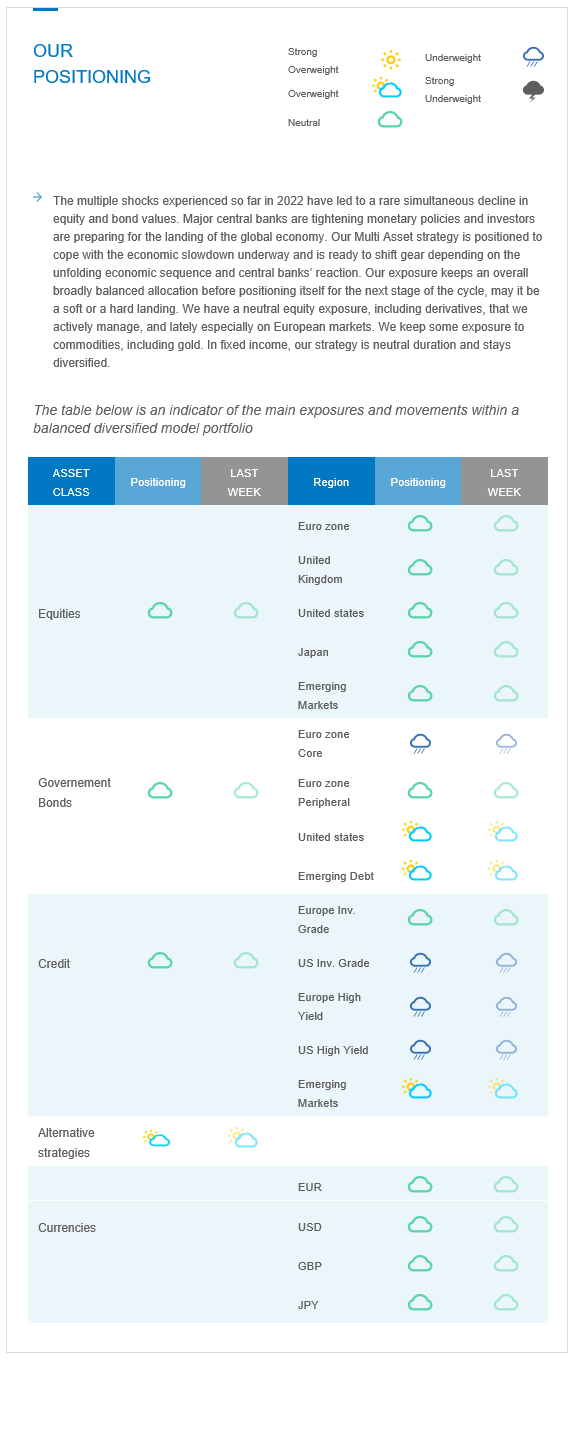Last Week in a Nutshell
- The US job report for June exceeded market expectations, adding 372K new jobs during the month despite concerns about the economic slowdown in the country. This is a strong number which should keep the US Federal Reserve (Fed) on track to deliver its planned 75bp interest rate increase in July.
- The minutes from the European Central Bank (ECB) kept the door open to a possibility of a larger than 25bps interest rate increase, to be decided at their meeting on 21 July. The ECB also provided some insight into the anti-financial fragmentation risk tool. In the US, the FOMC minutes acknowledged that “an even more restrictive stance could be appropriate if elevated inflation pressures were to persist”. The Euro accelerated its decline towards US dollar parity.
- PMIs for key countries revealed no synchronisation in global activity levels. China’s economy showed renewed strength, especially in the private sector. The Euro Area’s composite was the lowest reading since February 2021. In the US, new business was down across manufacturing and non-manufacturing sectors.
- Boris Johnson announced his resignation as UK Prime Minister after serving for nearly 3 years. He will step down as soon as his successor is chosen by the governing Conservative Party.
What's Next?
- Investors expect soft data releases in the Euro Area and Germany with the ZEW economic sentiment for July. The index had shown a slight deterioration last month and was already in deeply negative territory, as pessimistic analysts outnumbered optimistic ones.
- The US will follow with preliminary data stemming from the Michigan University on consumer sentiment, consumer expectations and inflation expectations. These leading indicators are important to retailers, economists and investors, and can give clues as to where the economy is headed.
- A series of data on inflation will be published but while most central banks are now trying to address this problem by tightening their monetary policies, market participants are increasingly focused on the aftermath. To which extent economic growth will keep up or fade away?
- China will publish its latest GDP growth figures for the second quarter of the year, when the country was still partially in COVID-19 lockdown, with Shanghai harbour especially affected. The few latest quarterly growth readings for China showed that services were the biggest positive contributor to economic activity, outshining its traditional growth engines, manufacturing and construction.
Investement Convictions
Core scenario
- While the market environment still appears constrained by deteriorating fundamentals, markets are looking forward to the upcoming central bank announcements in July.
- Facing multi-decade high inflation, the Fed started its hiking cycle in March and plans to add further giant steps to its funds rate by end-July and continue tightening thereafter. In our best-case scenario, the Fed succeeds in soft landing the economy despite the narrowing window. As a result, we expect the rise in the US 10Y yields to fade.
- Inflation is also at highs in the euro zone, hitting businesses, consumers, and ECB policymakers alike. The ECB pre-announced an initial rate hike for the month of July. Investors expect the announcement of new tools to address the risk of financial fragmentation.
- Facing high inflation, central bank policy tools have triggered a sharp tightening in financial conditions while the global economic slowdown is now well underway. The war in Ukraine and the slowing global weigh on confidence. The economic activity in China slowed down considerably in April and May but should pick up during H2 as stimulus measures kick-in.
- The reasons for a balanced allocation have therefore not changed in recent weeks: The risks we previously outlined are starting to materialize and are now part of the scenario as the economy prepares for landing, whether it be soft or hard.
Risks
- The war in Ukraine is pushing upwards commodity prices in general and prices for energy in particular and continues to add to market uncertainties. European gas prices are at the mercy of flows staying open.
- A brutal, faster-than-anticipated rate tightening - if inflationary pressures increase further or simply persist at current levels- could jeopardize any soft landing.
- Other countries may face the Bank of England (BoE) stagflation dilemma: Even as the growth outlook deteriorates sharply, signs of upward pressure on inflation expectations, near-term wage and price setting behaviours remain.
- The threat of COVID-19 and its variants remain as the virus keeps evolving and spreading further.
Recent actions in the asset allocation strategy
The multiple shocks experienced so far in 2022 have led to a rare simultaneous decline in equity and bond values. Major central banks are tightening monetary policies and investors are preparing for the landing of the global economy. Our Multi Asset strategy is positioned to cope with the economic slowdown underway and is ready to shift gear depending on the unfolding economic sequence and central banks’ reaction. Our exposure keeps an overall broadly balanced allocation before positioning itself for the next stage of the cycle, may it be a soft or a hard landing. We have a neutral equity exposure, including derivatives, that we actively manage, and lately especially on European markets. We keep some exposure to commodities, including gold. In fixed income, our strategy is neutral duration and stays diversified.
Cross asset strategy
- Our multi-asset strategy is staying agile. Our current positioning stays more tactical than usual and can be adapted quickly in this highly volatile context:
- Neutral euro zone equities, with a preference for the Consumer Staples sector, and with a derivative strategy in place to catch the asymmetric upside potential.
- Neutral UK equities, resilient segments, and global exposure
- Neutral US equities, with an actively-managed derivative strategy, as we remain attentive to the Fed’s forward guidance.
- Neutral Emerging markets, because our assessment indicates an improvement, especially in China, both on the COVID-19 / lockdown and stimulus fronts during H2.
- Neutral Japanese equities, as accommodative central bank, and cyclical sector exposure act as opposite forces for investor attractiveness.
- With some exposure to commodities, including gold.
- In terms of sectors, we favour the “long duration” assets, i.e. tech names, as we expect less headwinds from bond yields. We focus on software companies, less cyclical and less depending on consumer confidence, over semiconductors, that are more dependent on the consumer’s behaviour.
- In the fixed income universe, we acknowledge downward revisions in growth, highs in inflation expectations and strong central bank rhetoric regarding the willingness to tighten and fight inflation. We are neutral duration, with a preference for US duration.
- We continue to diversify and source the carry via emerging debt.
- In our long-term thematics and trends allocation: While keeping a wide spectrum of long-term convictions, we will favour Climate Action (linked to the energy shift) and keep Health Care, Innovation, Demographic Evolution and Consumption.
- In our currency strategy, we are positive on commodity currencies:
- We are long CAD.

